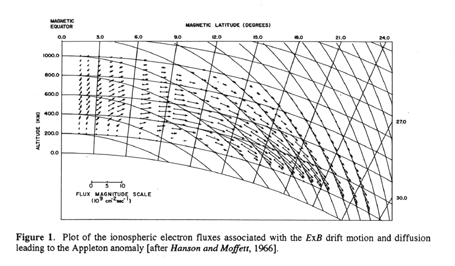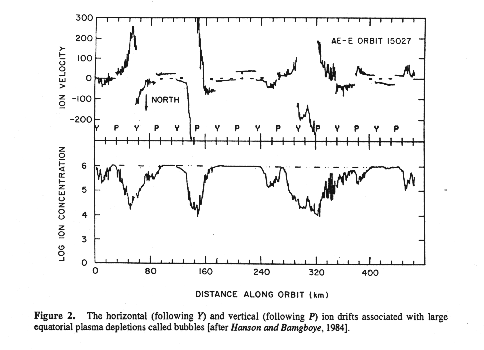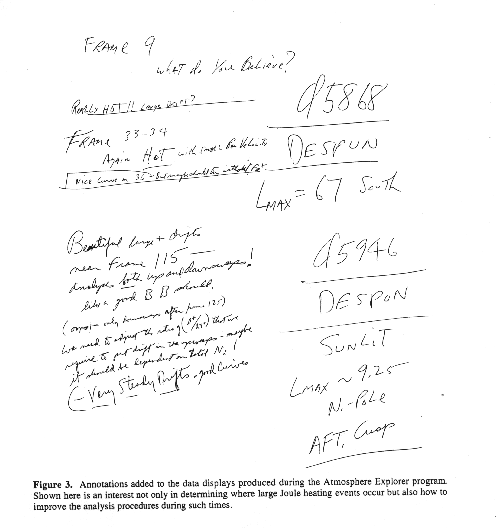Graduate Research Center of the Southwest
Lloyd Berkner was named President of the Graduate Research Center of the Southwest (GRCSW), which was housed on the SMU campus.
Earth and Planetary Sciences Laboratory at SCAS
Francis Johnson headed the Earth and Planetary Sciences Laboratory at GRCSW and William Hanson was recruited to join the team. Erik Jonsson, chairman of the board of the Center, and of Texas Instruments, announced the formation of Southwest Center for Advanced Studies (SCAS) to be administered by GRCSW and housed on a new campus in Richardson.
Atmospheric and Space Sciences at UT Dallas
The continued success of SCAS, coupled with increasing need to expand the research and educational opportunities, led to the transfer of activities, buildings and the land to The University of Texas system. The University of Texas at Dallas was formed as a graduate school at that time. Professor William B. Hanson became Director of the Division of Atmospheric and Space Sciences, which later became the Center for Space Sciences in the Physics Program at UT Dallas. He remained Director of the center until his passing in 1994.
William B. Hansen Center for Space Sciences
In recognition of his efforts to build a center of international excellence, in 1995 the Center for Space Sciences was named The William B. Hanson Center for Space Sciences. Professor Rod Heelis is appointed Director of the William B. Hanson Center for Space Sciences
UT Dallas Magazine article
“Across Space and Time“

William B. Hanson 1923 – 1994:
A Retrospective
R.A. Heelis
William B. Hanson Center for Space Sciences
The University of Texas at Dallas
Richardson, TX 75080
Bill Hanson has said that he was fortunate to have his career span the period marking the beginning of the space age and in some respects the dawn of the computer age. However, as he did with every aspect of his life, he recognized the opportunities offered by these circumstances and capitalized upon them to the fullest extent possible. His work is noted for its breadth and depth, but perhaps most notably for the thoroughness in his examination of a chosen problem.
After his graduate training in experimental low temperature physics he moved to Lockheed Space and Missiles Corporation in 1956 and pursued the development of techniques to measure ionospheric parameters. His drive to understand the behavior of the ionosphere beyond the descriptions provided by measurement alone, would also result in contributions to advances in numerical modeling and basic, but fundamental, mathematical and physical evaluations designed to expose the most important processes at work.
Hanson moved to the newly formed Southwest Center for Advanced Studies in1962. There he played a leading role in the formation of the Center for Space Sciences which became part of the University of Texas at Dallas in 1969. He continued in his role as the Center director and as a professor of physics until his death in 1994. Throughout his career Bill Hanson continued to keep abreast of the advances being made in the field and was driven by an intense curiosity about the underlying physics of the ionosphere. His early work illustrates the rather unique combination of contributions to the interpretation of observations and to the development of both observational and computational tools to further the investigation of the terrestrial upper atmosphere. A long-standing collaboration with scientists from the United Kingdom allowed ideas concerning the distribution of neutral and ionized species in the topside ionosphere to be developed. Inspired initially by whistler measurements [Storey, 1953], an investigation of the diurnal variation of the ion concentration in the protonosphere, led to a detailed understanding of the coupling between the ionosphere and the protonosphere and the development of mathematical models that could describe the coupling processes [Hanson and Patterson, 1964]. This work highlighted the importance of plasma transport perpendicular to the magnetic field as well as the diffusion of plasma along the magnetic field and appropriate chemical reactions. A combination of physical interpretation of available observations, mathematical manipulation of the relevant diffusion equations, and refinement of numerical techniques for solving differential equations eventually produced a rather robust model of the ionospheric plasma [Sterlinget al., 1969], and provided the foundation upon which many of the most sophisticated models now rest.

The power and utility of such a model in handling the transport and chemistry of the ionospheric plasma was demonstrated in a description of the ionospheric fountain effect [Hanson and Moffett, 1966] giving rise to the Appleton anomaly. Figure 1, showing the plasma motion resulting from ExB drift and diffusion of ions near the dip equator, has been used by scientists and educators alike to aid in interpretation and understanding of the equatorial ionosphere. In addition to being observed from the ground, the Appleton peaks were also observed in some of the first airglow measurements from space. With his interest in the anomaly sparked by recent modeling efforts, Hanson [1969] showed that airglow enhancements might be expected in these regions of enhanced concentration due to the radiative recombination of O+, a fact that is now well established and used with great success to provide a powerful remote sensing of the region.
During this same period Hanson began the evaluation of measurements from rocket and satellite borne ion traps. [Hanson and McKibbin, 1961, Hanson et al., 1964]. These rather simple devices, were the forerunners of what is now the planar retarding potential analyzer (RPA) that has been flown successfully on the OGO-6 satellite, the Atmosphere Explorer (AE) satellites, the Dynamics Explorer (DE) satellite, the San Marco-D satellite, and the Defense Meteorological Satellite Program (DMSP). Following the first measurements from the RPA on OGO 6 we see the fondness for a combination of observed phenomena, physical interpretation, and confirmation modeling, being revealed in the work of Bill Hanson. The discovery of Fe+ at high altitudes on OGO 6 and the suggestion that they are transported to such altitudes by ExB drifts [Hanson and Sanatani 1970], was followed by modeling efforts to reinforce this hypothesis [Hanson et al., 1972]. Measurements of unusually low ion temperatures near the dip equator were thought to be due to adiabatic expansion of the plasma as it moved along the magnetic field lines [Hanson et al.,1973]. This hypothesis was subsequently reinforced by calculations of the effect that showed the measurements to be consistent with expected inter hemispheric transport velocities [Bailey et al., 1973]. It is particularly interesting to note that the OGO 6 RPA provided some of the first in-situ measurements of equatorial plasma irregularities termed spread-F plasma [Hanson and Sanatani, 1973], and later to be termed “plasma bubbles.” These observations sparked an interest in Bill Hanson that continued throughout this career. Indeed, some of his most recent work concerned the properties of the bubble plasma at altitudes near 800 km [Hanson and Urquhart, 1994].
The initial observations and studies, stimulated by the wealth of data from OGO 6, led to Hanson’s intimate involvement in the development of the Atmosphere Explorer project. A relatively small group of scientists at universities, NASA field centers, and NASA Headquarters, spear-headed this effort that was to provide a wealth of data that is still being examined by scientists around the world. For this project it became clear that a measurement of the plasma motion was essential to the resolution of many of the problems being posed. With this motivation Hanson used his considerable experimental skills to design an ion drift meter (IDM) to be flown on AE-C, AE-D, and AE-E. Further refinements to the drift meter have been made since that time, but the simple yet elegant design remains at the core of this sensor that has provided key measurements for the subsequent DE mission and DMSP. Figure 2 shows measurements of the total ion concentration and the horizontal (Y), and vertical (P), ion drift velocities obtained from the IDM on the Atmosphere Explorer satellite. Data like this, taken at low and high latitudes, have been used by a large number of scientists to increase our understanding of plasma structure throughout the F-region ionosphere.

In addition to the recurring research problems attached to interhemispheric plasma transport, spread-F, and meteoric ions, the AE mission opened new avenues of research into ionospheric chemistry and electrodynamics that also peaked the interest and imagination of Hanson. The development of more capable mass spectrometers led to accurate observations of most of the ionospheric state variables, leaving only the chemical reaction rates to be evaluated [Torr et al., 1977]. Measurement of the ionospheric drift velocity vector provided an opportunity to more fully understand the ionospheric plasma circulation at high latitudes and the coupling between the ionosphere and the magnetosphere [Heelis et al., 1976]. These new missions also saw the development of computer systems designed to disseminate the data to a broader science community. It is evident that Hanson understood that it was not only necessary to disseminate the data, but also to share the intimate knowledge of its advantages and its shortcomings. All who have worked with Bill Hanson have benefited greatly from the enthusiasm with which he shared the findings from the data, and his ideas about the measured behavior of the ionosphere.
Along with his interest in the terrestrial ionosphere, Hanson shared a similar curiosity about the ionospheres and atmospheres of the other planets. In1969 he began working with the entry science team of the Viking mission to Mars. The implementation phase was extraordinarily long, at that time, but new and exciting data was provided by the RPA, designed by Hanson, when the spacecraft arrived at Mars in the summer of 1976 [Hanson et al., 1977]. In fact this data set has provided continued challenges to our understanding of the interaction of the planet with the interplanetary medium, resulting in publications as recent as 1992 [Johnson and Hanson, 1992].

The breadth of Hanson’s work is accompanied by an underlying and constant interest in the ubiquitous nature of irregularities in the ionospheric plasma. From the first observations of backscatter plumes and satellite measurements in the late 60’s and early 70’s it is clear that Hanson has advanced our understanding of this phenomena, with detailed descriptions of the phenomenology involved, and insights into the physical principles that must be adhered to. He described a special class of irregularities with a discrete spatial scale size on the bottom side of the F-region [Valladares et al., 1982]. He examined the relationships between plasma motion parallel and perpendicular to the magnetic field inside plasma bubbles [Hanson and Bamgboye, 1984] and most recently noted that bottom side ionospheric irregularities may be observed as high as 800 km in the equatorial region [Hanson and Urquhart, 1994].
At all times Bill Hanson’s propensity to study the data at all locations and all conditions shows through. Continued study of the AE data allowed details of ion sputtering from spacecraft surfaces to be revealed [Hanson et al.,1981], which may be useful to future low altitude missions. In the F-region, the geometry of the DE satellite and its orientation to the magnetic field produces and interesting plasma interaction with the surface, [Cragin et al., 1993]leading to density structure that is an artifact rather than a geophysical signature. In addition, Hanson was constantly alert to the need for new, or more efficient, measurement techniques and, just prior to his death, had developed a satellite borne transverse neutral wind detector as part of a collaboration with scientists and engineers in Italy [Hanson et al., 1992]. Most recently the confidence levels with which interpretation of electric fields and ion drifts may be made has been well documented for future reference [Hanson et al., 1994]. Hanson’s long and tireless hours spent pouring over the data, coupled with a broad knowledge of the physical principles involved in its interpretation, produced a world renowned “gastric computer” and one of the best human “expert systems” to be used by most scientists in the field. Figure 3 shows just two entries in the many notations made on each data segment display from the Atmosphere Explorer mission. The remarks show the interest and enthusiasm with which Bill studied the data and that he continually strived to improve the performance of the analysis and interpretation procedures that were used.
Beyond the work of Bill Hanson, reflected in the published record, is a reputation for inspiring excellence and thoroughness in others. His ability to understand the basic physical principles involved in most scientific endeavors made him an ideal and frequently used “sounding board”. His opinion sand insights were highly respected and he served valuably on many advisory panels to national and international institutions. He also served as president of the Solar Terrestrial Physics Section of the American Geophysical union from 1978 to 1980.
I once asked Bill Hanson what part of ionospheric science he found most interesting. He replied “I’m a beachcomber. I really enjoy just looking at the data, any data really. I can always find some repetitive little signature that gets my attention and then I try to understand it well enough to figure out where it comes from.” The work of Bill Hanson attests to his outstanding ability to identify important signatures and perhaps, equally important are the numerous interactions that continue to inspire the work of his colleagues and students and attest to his desire to share this fascination for the “beach” with everyone.
It is quite straightforward to reflect on the many scientific achievements of Bill Hanson and to recognize the talent and dedication that accompanies this work. However, it is particularly hard to document the features of Bill Hanson’s career that I believe will be also warmly remembered. These involve the way he approached personal and professional challenges, and the way he interacted with the many colleagues who became his friends around the world. In 1985 he was awarded the John Adam Fleming Medal by the AGU in recognition of unselfish contributions to the study of ionospheric physics and aeronomy. Bill Hanson also cared about people and the environment in which they live. His solutions to some of the environmental and social issues of the day, were sometimes controversial, but his goal was always to maximize the quality of life for all. As one who was privileged to be close to this man I can say that few things gave him greater pleasure than the sharing of his knowledge and his ideas with the friends that surrounded him.
REFERENCES
Bailey, G. J., R. J. Moffett, W. B. Hanson, and S. Sanatani, Effects of Inter hemisphere Transport on Plasma Temperatures at Low Latitudes, J.Geophys. Res., 78, 5597, 1973
Cragin, B. L., and W. B. Hanson, Equatorial spacecraft-plasma interaction phenomenon observed by DE 2, J. Geophys. Res., 98, 19,141,1993.
Hanson, W. B., Radiative Recombination of Atomic Oxygen Ions in the Nighttime F Region, J. Geophys. Res., 74, 3720, 1969
Hanson, W. B. and D. K. Bamgboye, The Measured Motions Inside Equatorial Plasma Bubbles, J. Geophys. Res., 89, 8997, 1984
Hanson, W. B. and R. J. Moffett, Ionization Transport Effects in the Equatorial F Region, J. Geophys. Res., 71, 5559, 1966
Hanson, W. B. and D. D. McKibbin, An Ion-Trap Measurement of the Ion Concentration Profile Above the F2 Peak, J. Geophys. Res., 66,1667, 1961
Hanson, W. B., D. D. McKibbin, and G. W. Sharp, Some Ionospheric Measurements with Satellite-Borne Ion Traps, J. Geophys. Res., 69,2747, 1964
Hanson, W. B., A. F. Nagy, and R. J. Moffett, OGO 6 Measurements of Supercooled Plasma in the Equatorial Exosphere, J. Geophys. Res., 78, 751, 1973
Hanson, W. B. and T. N. L. Patterson, The Maintenance of the Night-Time F Layer, Planet. Space Sci,, 12, 979, 1964
Hanson, W. B. and S. Sanatani, Meteric Ions above the F2 peak,J. Geophys. Res., 75 5483, 1970
Hanson, W. B. and S. Sanatani, Large Ni Gradients Below the Equatorial F Peak, J. Geophys. Res., 78, 1167, 1973
Hanson, W. B., S. Sanatani, and D. R. Zuccaro, The Martian Ionosphere as Observed by the Viking Retarding Potential Analyzers, Special Viking Issue, J. Geophys. Res., 82, 4351, 1977
Hanson, W. B., D. L. Sterling, and R. F. Woodman, Source and Identification of Heavy Ions in the Equatorial F Layer, J. Geophys. Res., 77, 5530, 1972
Hanson, W. B., S. Sanatani, and J. H. Hoffman, Ion Sputtering from Satellite Surfaces, J. Geophys. Res., 86, 11,350, 1981
Hanson, W. B., U. Ponzi, C Arduini, and M. Di Ruscio, A satellite anemometer, J. Astronaut. Sci., 3, 429, 1992.
Hanson, W. B., W. R. Coley, R. A. Heelis, N. C. Maynard, and T. Aggson, A comparison of in situ measurements of E and -VxB from DynamicsExplorer-2, J. Geophys. Res., 98, 21,501, 1994.
Hanson, W. B. and A. L. Urquhart, High Altitude Bottom side Bubbles?, Geophys. Res. Lett., 21, 2051, 1994
Heelis, R. A., W. B. Hanson, and J. L. Burch, Ion Convection Velocity Reversals in the Dayside Cleft, J. Geophys. Res., 81, 3803, 1976
Johnson, F. S. and W. B. Hanson, Viking 2 Electron Observations at Mars, J. Geophys Res., 97, 6523, 1992
Sterling, D. L., W. B. Hanson, R. J. Moffett, and R. G. Baxter, Influence of Electromagnetic Drifts and Neutral Air Winds on Some Features of the F2 Region,” Radio Science, 4, 1005, 1969
Storey, L. R. O., An Investigation of Whistling Atmospherics, Phil. Trans. Roy. Soc., A, 246, 113, 1953
Torr, D. G., N. Orsini, M. R. Torr, W. B. Hanson, J. H. Hoffman, and J. C. G. Walker, Determination of the Rate Coefficient for the N2++ O Reaction in the Ionosphere, J. Geophys. Res., 82, 1631, 1977
Valladares, C. E., W. B. Hanson, J. P. McClure, and B. L. Cragin, Bottom side Sinusoidal Irregularities in the Equatorial F Region, J. Geophys. Res., 88, 8025, 1983